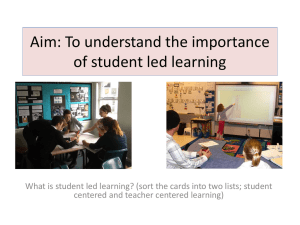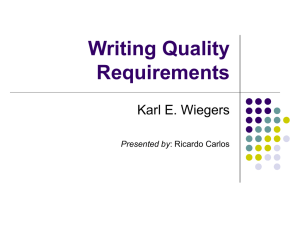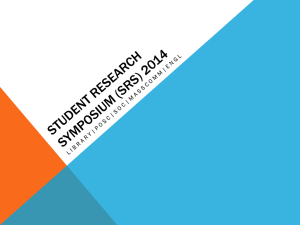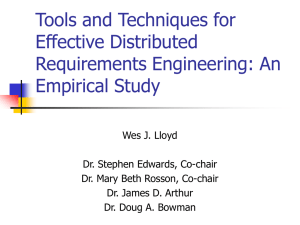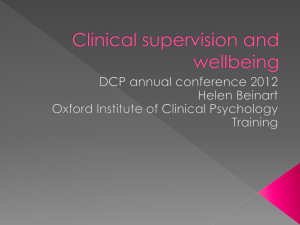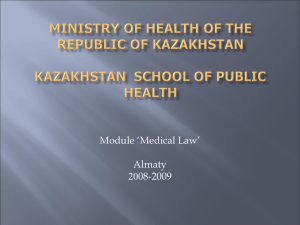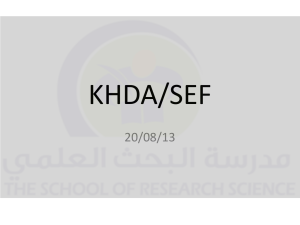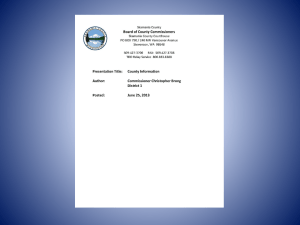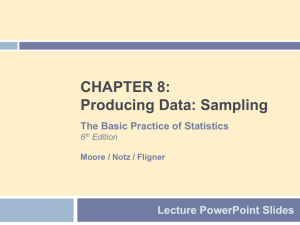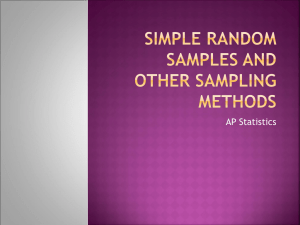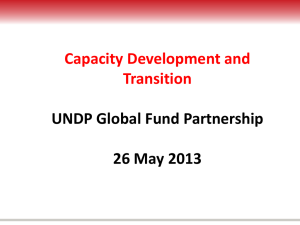ppt
advertisement
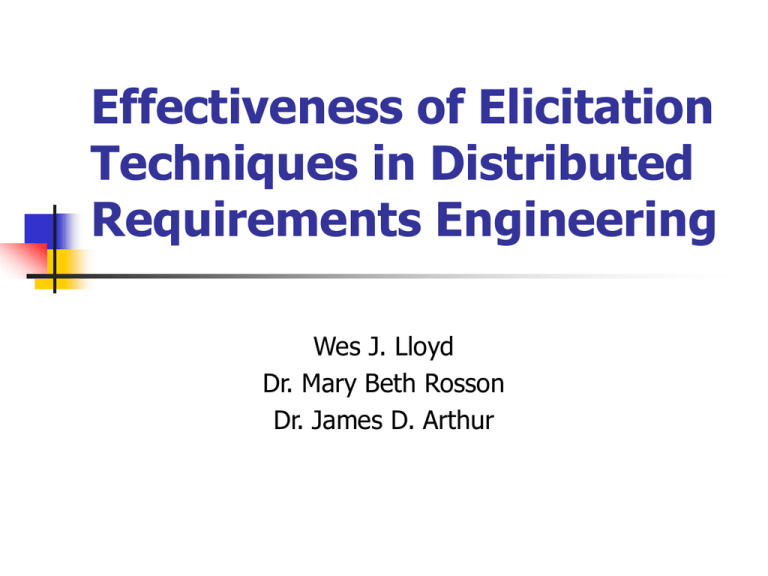
Effectiveness of Elicitation Techniques in Distributed Requirements Engineering Wes J. Lloyd Dr. Mary Beth Rosson Dr. James D. Arthur Outline Introduction Project Overview Assessing SRS Quality Results and Conclusions SRS Quality Requirements Elicitation Techniques Effectiveness 2 Why Distributed Requirements Engineering? Client request for on-site support Project members can not travel or relocate Skilled workers not available Reduce travel / relocation costs Hardware, software resources only available at certain locations 3 Disadvantages of Distributed Software Engineering Coordination and versioning of work artifacts (documents, code) across multiple sites No unplanned meetings Difficulty making contact with remote team Difficulty knowing whom to contact from remote group Misunderstood priority of information requests Language differences Time zone differences 4 Groupware Time-Space groupware taxonomy Same Time Different Time Face-to-face Interaction Asynchronous Interaction Synchronous Distributed Interaction Asynchronous Distributed Interaction Centra Symposium, MOOsburg MOOsburg, Email Same Place Different Places 5 Research Goals 1) Assess SRS document quality Correlate factors that affected document quality 2) Determine which Groupware Tools best support (DRE) Distributed Requirements Engineering 3) Determine which Requirements Elicitation Techniques work best for DRE 6 Outline Introduction Project Overview Assessing SRS Quality Results and Conclusions SRS Quality Requirements Elicitation Techniques Effectiveness 7 DRE Empirical Study CS5704 Software Engineering students CS5734 Computer Supported Cooperative Work Students Role-play as requirements engineers Role-play as customers GOAL: To specify a company wide scheduling system 8 Requirements Engineering Process 1) Capture high-level user requirements 2) Requirements elicitation, and analysis 3) Write the software requirements specification document (SRS) 4) Verification and revision of specification document 9 Virtual Meetings Four planned formal sessions Meeting 1 Meeting 2, 3 Introduction, high level requirements Requirements elicitation, management Meeting 4 SRS review 10 Centra Symposium 11 Centra Symposium 1:many audio conferencing Application sharing Shared whiteboard Public, private synchronous chat Slideshow Voting Shared web browser 12 MOOsburg 13 MOOsburg Room based collaborative environment Asynchronous and synchronous collaboration Shared whiteboard Text chat File sharing Shared list editor 14 Group List Server Messages distributed to all group participants Asynchronous collaboration 15 Requirements Elicitation Techniques Brainstorming / Idea Reduction Planned Formal Interviews Ad Hoc Question and Answer Storyboards Use Cases Prototyping Written Questionnaires Requirements Prioritization / Elimination Requirements Management 16 Customer Roles Secretary Engineer Currently in charge of scheduling at the company Concerned about ease of use and job security Technical person with ideas for system features Very busy with customers Vice President Primary concern is to keep project on budget Familiar with computer buzzwords, but not their meaning 17 Team Formation Requirements Engineers Results of Software Engineering/Programming experience survey used to balance team experience Customers Belbin Self-Perception Inventory used to measure participant’s natural role tendencies. Roles assigned based on role measurement 18 Participant Instruction Groupware tutorial Class session on use of Centra Symposium and MOOsburg For requirements engineers and customers Requirements Engineering Tutorial Class session on Requirements Engineering as applicable to the empirical study For requirements engineers 19 Distributed Meeting Facilities Lab facilities Torgersen Hall Room 3060 – 3rd floor Torgersen New Media Lab – 1st floor Networked PC workstations with headset microphones Centra Symposium, and MOOsburg client on all machines 20 Data Collection Note taking of observations for all virtual meetings Meetings recorded via Symposium client Multiple Surveys 21 Surveys Software engineering and programming experience survey Requirements engineering experience survey Post meeting #1 survey Post meeting #2, #3 requirements engineer survey Requirements Engineer Peer participation survey Final online survey 22 Outline Introduction Project Overview Assessing SRS Quality Results and Conclusions SRS Quality Requirements Elicitation Techniques Effectiveness 23 SRS Quality Measurement Overall SRS Quality is average of these four metrics SRS Grade Student assessment Professor impression of SRS document quality Assigned as a percentage Document Evolution Measurement of SRS maturity Requirements are enumerated Requirements are classified as having evolution or not. Value is percentage of total requirements with evolution 24 SRS Quality Measurement - 2 Requirements Evaluation Requirements are enumerated Requirements are classified based on defect type. Ambiguous Incomplete Inconsistent Not Traceable Not Verifiable Value is the percentage of defect-free requirements 25 SRS Quality Measurement - 3 Original Requirements Number of original requirements supported is counted. Value is percentage of original requirements supported 26 Outline Introduction Project Overview Assessing SRS Quality Results and Conclusions SRS Quality Requirements Elicitation Techniques Effectiveness 27 SRS Quality High Performance Groups Group 1 79.34 % Group 2 77.32 % Group 3 76.44 % Group 5 75.96 % Low Performance Groups Group 4 69.11 % Group 6 66.85 % 28 SRS Quality Overall SRS Quality 350% 300% 67.6% Sum of SRS Document Metrics 70.6% % of Total Original Function Points 69.1% 75.0% 55.9% 250% 82.4% 84.2% 200% 75.0% 51.3% 59.6% 67.4% 42.9% 150% 72.7% 72.7% 87.5% % of Requirements without Errors % Requirements with Evolution SRS Grade % 84.1% 78.1% 77.2% 100% 50% 93.0% 91.0% 92.0% 91.0% 75.0% 65.0% 0% 1 2 3 5 4 6 Group 29 SRS Quality: Results - 1 Groups who reported lower effectiveness of requirements elicitation techniques produced higher quality SRS documents r(df=4)=-.74, p < .09 Close investigation shows that the scores for the Ineffectiveness of Prototyping and Questionnaires for groups with high SRS quality created this trend. 30 SRS Quality: Results - 2 Low Performance Groups Unsatisfied with Customer Participation 56% of the group members were unsatisfied with customer participation 12% of the group members were unsatisfied with customer participation from High Performance Groups 31 SRS Quality: Results - 3 Groups who reported Symposium Text Chat as a more effective tool produced lower quality SRS documents. r(df=4)=-.73, p<.10) Groups with lower SRS quality used text chat more frequently because of language barriers. Notably Groups 2 & 4 "some customers ( do to their lack of english knowledge ) didn't participate in the req process as much as they had to" 32 SRS Quality: Results - 4 Groups who obtained more information using email tended to produce lower quality SRS documents. r(df=4)=-.64, p<.17) Low performance groups did not receive enough feedback from virtual meetings and therefore relied on email for information gathering. Poor planning for meetings Poor administration of meetings Language barriers with customer 33 Outline Introduction Background Project Overview Assessing SRS Quality Results and Conclusions SRS Quality Requirements Elicitation Techniques Effectiveness 34 Requirements Elicitation Technique Effectiveness Perceived Effectiveness of Requirements Analysis Methods 5.00 Q/A Method 4.50 4.50 4.31 Customer Interviews 4.00 3.81 3.69 3.50 Storyboards 3.19 Effectiveness Brainstorming / Idea Reduction 3.46 3.00 2.65 Prototyping 2.50 Questionnaires 2.00 Use Cases 1.62 Requirements Management 1.50 1.00 0.50 0.00 Methods 35 Requirements Elicitation: Results Requirements Management is more effective when the engineer(s) applying the method have more experience with it. r(df=24)=.30, p<.03 Brainstorming is an effective requirements analysis technique when participants are active in virtual meetings. r(df=44)=.30, p<.05 36 Requirements Elicitation: Results - 2 Questionnaires tended to be an effective requirements analysis technique when customers participate actively outside of virtual meetings. r(df=24)=.30, p<.14 37 Requirements Elicitation: Results - 3 Requirements Elicitation techniques in general are more effective when customers participate actively in virtual meetings. r(df=24)=.42, p<.05 Q/A method has the strongest correlation with perceived customer participation. "If they were more proactive and put more effort into participation we could have accurately captured what they really wanted and elicited what they hadn't thought of. Instead, they constantly said yes to our suggestions ..." 38 Conclusions Customer Participation is important for effective Distributed Requirements Engineering Groups which relied on synchronous Requirements Elicitation Techniques by obtaining requirements information during the live sessions produced higher quality SRS documents Communication challenges led engineers to using text chat and email for requirements elicitation which tended to be less effective. 39 Future Work An empirical study to compare face-to-face versus distributed groups in requirements analysis Empirical studies with control variables to discover more about effectiveness for distributed requirements analysis Requirements Elicitation Techniques Groupware tools Synchronous vs. Asynchronous groupware tools Empirical studies with Requirements Engineers from industry 40 Future Work - 2 Empirical Studies with customers having a higher stake in project success Build a prototype groupware system with groupware functionality identified in this study, then conduct further empirical studies Video-conferencing Integrated System 41 Acknowledgements Dr. Stephen Edwards, Virginia Tech Dr. Doug A. Bowman, Virginia Tech CS5704 Spring 2001 Students CS5734 Spring 2001 Students Faculty Development Institute Pete Schoenhoff, Philip Isenhour, and more 42 Questions 43
